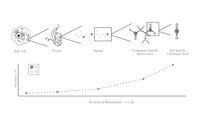
Photo from wikipedia
This study focuses on the application of stable carbon isotope analysis to determine the origin of commercial surfactants and cleaning products, especially used in quality process by chemical companies. The… Click to show full abstract
This study focuses on the application of stable carbon isotope analysis to determine the origin of commercial surfactants and cleaning products, especially used in quality process by chemical companies. The δ13C value was applied to commercial surfactants, such as ethoxylate alcohol, sodium lauryl sulfate, alkyl polyglucoside with different origin, that are the most common raw materials used in cleaning products. In this study, the isotopic analysis was performed on mixtures of commercial surfactants to simulate the commercial detergent formulations (handwashing, multisurface cleaner and degreaser) and then on bulk professional cleaning products to match relationship between isotope carbon composition and concentration of surfactants in real samples. This study demonstrated that δ13C was correlated to the origin of surfactants. In particular we analyzed five samples of biobased surfactants, with δ13C value from -22,6‰ to -28,0‰, and six samples from carbon fossil raw material, with δ13C value from -28,5‰ to -32,0‰, which were the most common raw material used in commercial cleaning products. Isotope carbon composition was also applied on mixtures of biobased and fossil surfactants to simulate and perform the method for stable carbon isotope analysis of commercial cleaning products. Furthemore the results assessed the relationship between stable carbon isotope ratio values and surfactant concentration in mixtures: for example in 50% mixtures of biobased (δ13C -22,6‰) and synthetic surfactant (δ13C -32,5‰), we found a δ13C value -28,00‰. The main advantage in using δ13C analysis is related to cheapness and easy-to-operate method in comparison to radiocarbon methodology.
Journal Title: Talanta
Year Published: 2020
Link to full text (if available)
Share on Social Media: Sign Up to like & get
recommendations!